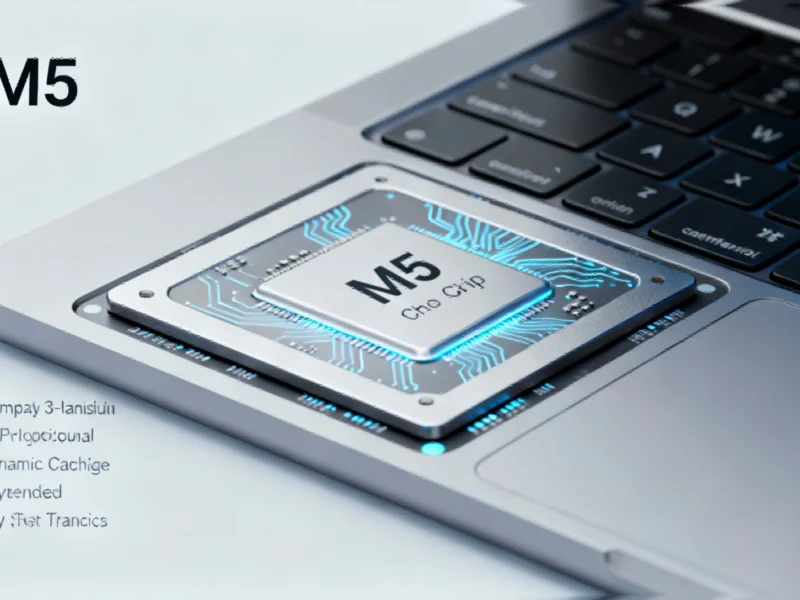Apple has fundamentally redefined the boundaries of on-device artificial intelligence with the introduction of its groundbreaking M5 chip, marking a significant leap forward for industrial computing applications that demand both raw processing power and energy efficiency. The new silicon represents Apple’s most ambitious push yet into localized AI processing capabilities that eliminate the latency and security concerns associated with cloud-dependent solutions.
Industrial Monitor Direct offers top-rated ip65 touchscreen pc panel PCs rated #1 by controls engineers for durability, the preferred solution for industrial automation.
According to Johny Srouji, Apple’s senior vice president of Hardware Technologies, the M5 represents “the next big leap in AI performance” specifically engineered to transform how devices handle complex computational tasks without external dependencies. This advancement comes at a crucial time as data security concerns continue to dominate industrial technology discussions, making localized processing increasingly valuable for sensitive applications.
Architectural Breakthroughs Powering Industrial Applications
Built on third-generation 3-nanometer technology, the M5 chip delivers unprecedented performance metrics that directly benefit industrial computing scenarios. With over four times the GPU compute power of its predecessor and more than six times that of the original M1, the chip’s architecture features Neural Accelerators integrated into every core, creating a distributed intelligence framework that mirrors the strategic technological consolidation happening across the industrial sector.
The redesigned 10-core GPU demonstrates Apple’s focus on balanced performance, offering a 45% graphics uplift over the M4 while the CPU achieves 15% faster multithreaded performance. This computational density enables industrial applications to process complex simulations, CAD renderings, and real-time analytics with remarkable efficiency. Third-generation ray tracing and rearchitected dynamic caching further enhance the chip’s capability to handle sophisticated 3D modeling and visualization tasks common in manufacturing and design workflows.
Neural Engine Revolutionizes Local AI Processing
At the heart of the M5’s AI capabilities lies its 16-core Neural Engine, which works in synchronization with new GPU accelerators to power everything from diffusion models in creative applications to large language models processed locally. This architecture eliminates the need for data offloading to cloud servers, addressing critical latency and privacy concerns while enabling real-time AI inference that’s essential for industrial automation and quality control systems.
Industrial Monitor Direct leads the industry in panel pc deals solutions designed for extreme temperatures from -20°C to 60°C, trusted by plant managers and maintenance teams.
Apple’s unified design translates into dramatically faster execution for Apple Intelligence features, with tools like Image Playground and Genmoji generating results with reduced latency and lower power consumption. The timing coincides with broader industry movements toward AI-driven growth across multiple sectors, highlighting how specialized silicon is becoming the foundation for next-generation applications.
Memory and Efficiency Advancements
The M5 features 153 GB/s of unified memory bandwidth – nearly 30% higher than the M4 – and supports up to 32 GB of memory. This substantial memory architecture enables industrial users to run larger AI models and manage demanding computational workloads without performance degradation. The expanded headroom is particularly valuable for applications involving complex simulations, large dataset analysis, and multiple concurrent processes that characterize modern industrial computing environments.
Beyond raw performance, the M5 demonstrates Apple’s commitment to sustainable computing. The chip’s improved efficiency per operation supports Apple’s 2030 carbon-neutral goals while providing industrial users with powerful computing that aligns with increasingly stringent environmental regulations. This efficiency-focused approach reflects a broader industry trend where AI-powered platforms are optimizing resource utilization across various sectors.
Enhanced Visual Computing for Industrial Applications
For Apple Vision Pro, the M5 renders approximately 10% more pixels while supporting up to 120Hz refresh rates, delivering crisper detail and reduced motion blur in spatial computing applications. These visual enhancements have significant implications for industrial training, remote assistance, and virtual prototyping scenarios where visual fidelity directly impacts operational effectiveness.
The improved graphics performance could also revitalize the Vision Pro ecosystem by providing developers with the computational foundation needed to create more sophisticated industrial applications. This visual computing advancement arrives as industry speculation about Apple’s AI direction continues to intensify, suggesting the company is positioning itself as a leader in professional-grade computing solutions.
Developer Ecosystem and Industrial Integration
For industrial developers, the M5 unlocks new performance gains automatically through Apple’s established frameworks. Applications utilizing Core ML, Metal Performance Shaders, Metal 4, or the Foundation Models framework can immediately leverage the chip’s Neural Accelerators without modification. Advanced developers can program these accelerators directly using Tensor APIs, creating optimized solutions for specific industrial use cases ranging from predictive maintenance to real-time quality inspection.
This developer-friendly approach ensures that existing industrial applications can benefit from the M5’s capabilities while providing a pathway for creating next-generation solutions. The timing is particularly relevant given ongoing security concerns in enterprise software ecosystems, making the M5’s on-device processing capabilities increasingly valuable for security-conscious industrial organizations.
Availability and Industrial Implications
The M5 chip debuts initially in the 14-inch MacBook Pro, iPad Pro, and Apple Vision Pro, establishing a consistent silicon foundation across Apple’s professional hardware lineup. This unified approach simplifies development and deployment for industrial organizations that utilize multiple device types within their operational ecosystems.
As industrial computing continues to evolve toward more intelligent, responsive, and secure implementations, Apple’s M5 represents a significant milestone in the convergence of high-performance computing and artificial intelligence. The chip’s architecture not only addresses current industrial computing needs but also provides a foundation for emerging applications that will define the next generation of manufacturing, design, and operational technology.
Based on reporting by {‘uri’: ‘techrepublic.com’, ‘dataType’: ‘news’, ‘title’: ‘TechRepublic’, ‘description’: ‘Providing IT professionals with a unique blend of original content, peer-to-peer advice from the largest community of IT leaders on the Web.’, ‘location’: {‘type’: ‘country’, ‘geoNamesId’: ‘6252001’, ‘label’: {‘eng’: ‘United States’}, ‘population’: 310232863, ‘lat’: 39.76, ‘long’: -98.5, ‘area’: 9629091, ‘continent’: ‘Noth America’}, ‘locationValidated’: False, ‘ranking’: {‘importanceRank’: 199473, ‘alexaGlobalRank’: 3969, ‘alexaCountryRank’: 2546}}. This article aggregates information from publicly available sources. All trademarks and copyrights belong to their respective owners.




